中职英语第二册 unit1 listening 教案
- 格式:doc
- 大小:55.50 KB
- 文档页数:4
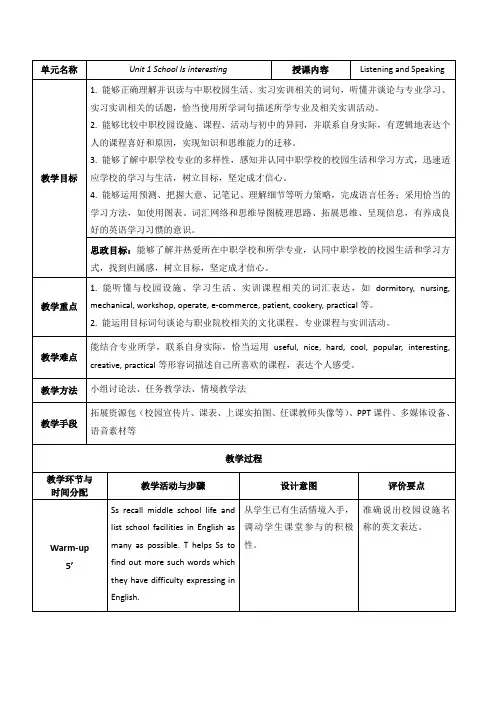
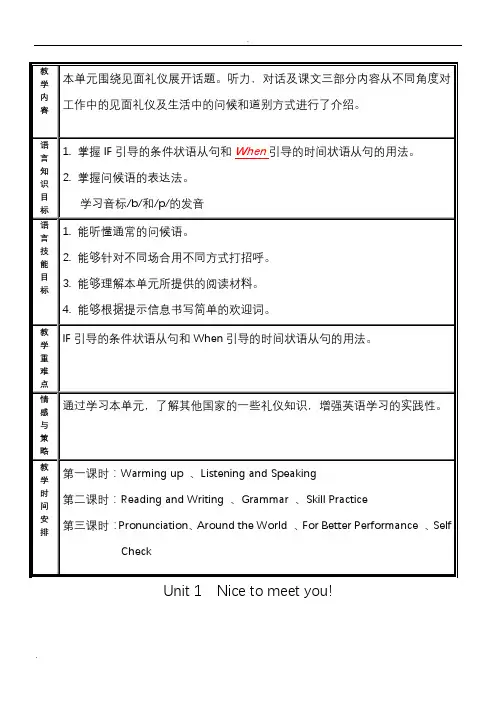
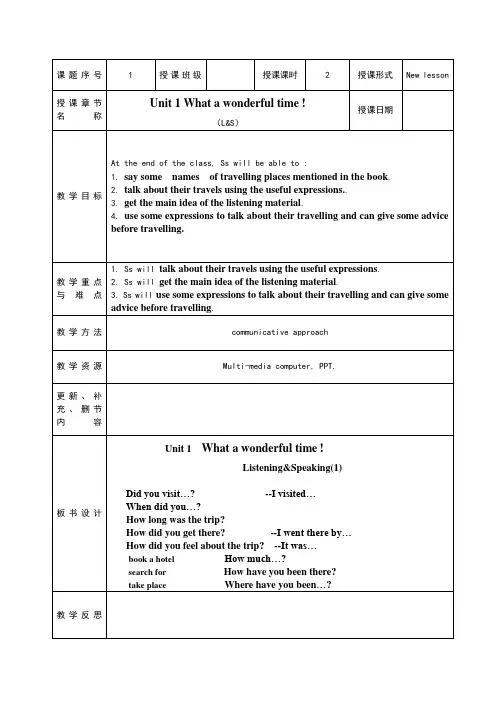
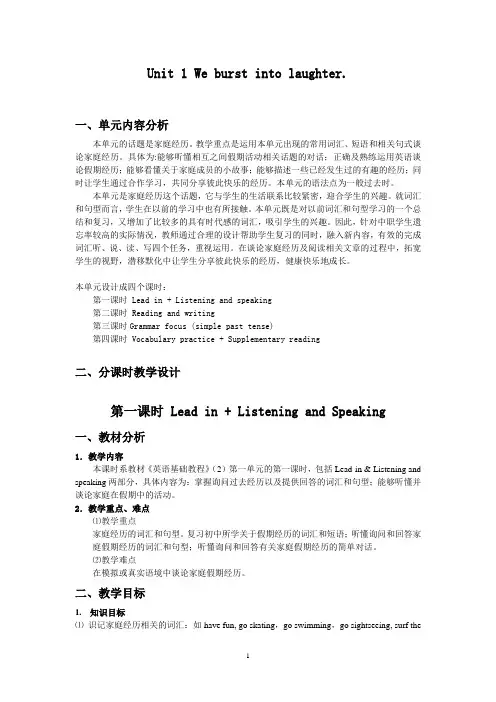

山东海事职业学院教案具体授课内容brilliant adj.excellent 卓越的,杰出的assemble v。
fit (parts)together组装,装配instant adj。
occurring immediately即刻的via prep.by way of 凭借,经由vanish v. disappear 消失,消散unexpected adj。
surprising 意外的cancer n.癌症executive n。
a manager in a company who helps make important decisions 经理,业务主管expectation n。
anticipation 期望,预期impressive adj。
arousing respect or admiration 令人印象深刻的aspect n。
feature 方面decade n。
ten years 十年perfectionist n.someone who is not satisfied with anything unless it is completely perfect 完美主义者bachelor n.a man who has not yet married 单身汉motorcycle n. a two-wheeled motor vehicle 摩托车proof n。
evidence 证据,证明engineering n。
application of science to design, building,and use of machines etc. financial adj。
relating to money or the management of money财政的,金融的salary n.fixed regular payment by employer to employee 薪金,薪水stock n。
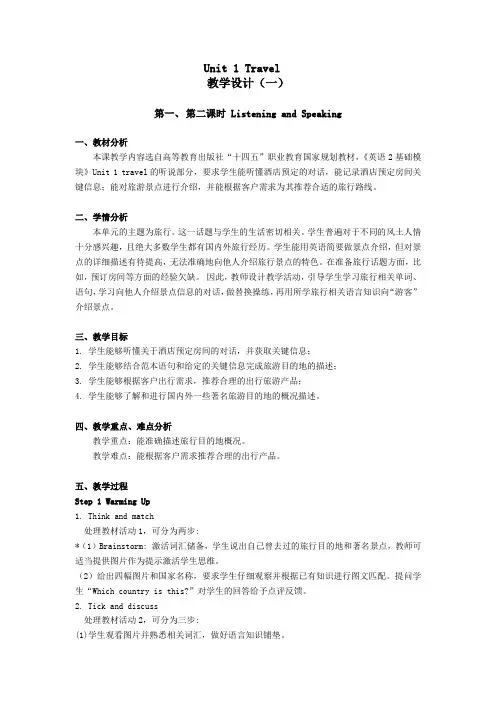
Unit 1 Travel教学设计(一)第一、第二课时 Listening and Speaking一、教材分析本课教学内容选自高等教育出版社“十四五”职业教育国家规划教材,《英语2基础模块》Unit 1 travel的听说部分,要求学生能听懂酒店预定的对话,能记录酒店预定房间关键信息;能对旅游景点进行介绍,并能根据客户需求为其推荐合适的旅行路线。
二、学情分析本单元的主题为旅行。
这一话题与学生的生活密切相关。
学生普遍对于不同的风土人情十分感兴趣,且绝大多数学生都有国内外旅行经历。
学生能用英语简要做景点介绍,但对景点的详细描述有待提高,无法准确地向他人介绍旅行景点的特色。
在准备旅行话题方面,比如,预订房间等方面的经验欠缺。
因此,教师设计教学活动,引导学生学习旅行相关单词、语句,学习向他人介绍景点信息的对话,做替换操练,再用所学旅行相关语言知识向“游客”介绍景点。
三、教学目标1. 学生能够听懂关于酒店预定房间的对话,并获取关键信息;2. 学生能够结合范本语句和给定的关键信息完成旅游目的地的描述;3. 学生能够根据客户出行需求,推荐合理的出行旅游产品;4. 学生能够了解和进行国内外一些著名旅游目的地的概况描述。
四、教学重点、难点分析教学重点:能准确描述旅行目的地概况。
教学难点:能根据客户需求推荐合理的出行产品。
五、教学过程Step 1 Warming Up1. Think and match处理教材活动1,可分为两步:*(1)Brainstorm: 激活词汇储备,学生说出自己曾去过的旅行目的地和著名景点,教师可适当提供图片作为提示激活学生思维。
(2)给出四幅图片和国家名称,要求学生仔细观察并根据已有知识进行图文匹配。
提问学生“Which country is this?”对学生的回答给予点评反馈。
2. Tick and discuss处理教材活动2,可分为三步:(1)学生观看图片并熟悉相关词汇,做好语言知识铺垫。
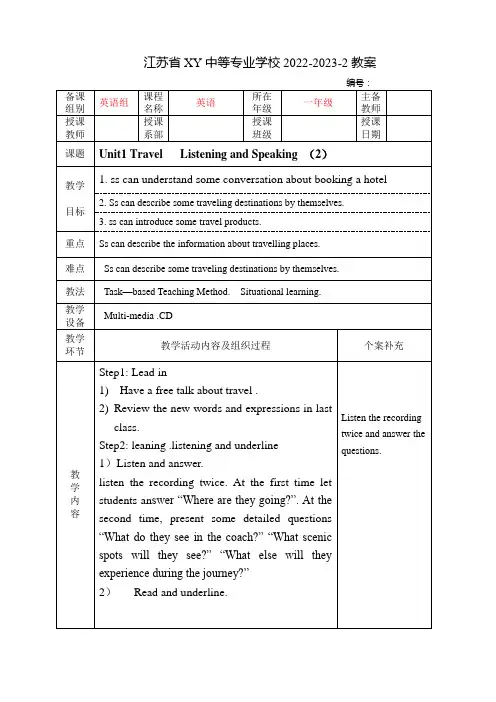
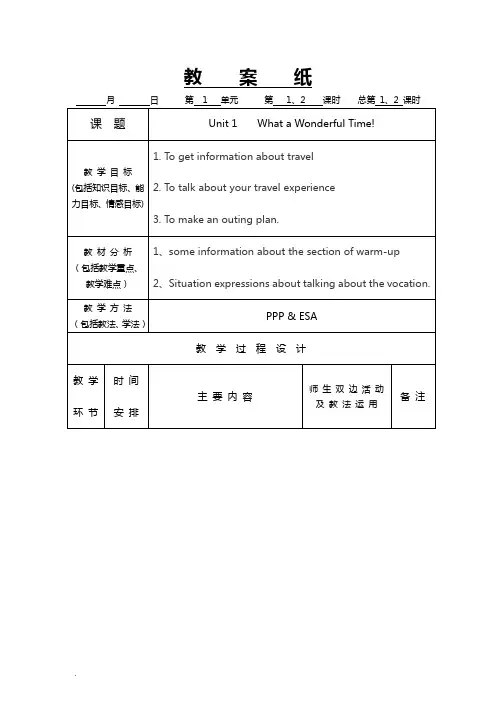
教案纸月日第 1 单元第1、2 课时总第1、2 课时课题Unit 1 What a Wonderful Time!教学目标(包括知识目标、能力目标、情感目标)1. To get information about travel2. To talk about your travel experience3. To make an outing plan.教材分析(包括教学重点、教学难点)1、some information about the section of warm-up2、Situation expressions about talking about the vocation.教学方法(包括教法、学法)PPP & ESA教学过程设计教学环节时间安排主要内容师生双边活动及教法运用备注.导入新课讲10’10’5’20'Lead-in: say something abouttravelingWords and expressions:1.ask the students topronounce;2.play the tape for thestudents to listen andrepeat.Dialogues:TravelingDialogue1.Listen to the tape andanswer the questions.2.Situation expressions:(1)Have you ever been to...?Yes, a wonderful place.No, I wish I could.(2)Did you visit...? Yes, Ivisited...(3)When did you visit...?I st year/a weekago.(4)How did you get there?I went there by...(5)Do you visit...by train?Pair workReadingExplanation授教学环节时间安排主要内容师生双边活动及教法运用备注新课归纳15’5’5’10’5’5’No, I visited the place onfoot..(6) How do you likeit?exciting...nguage points:(1)a bit(2)no matter(3)go wrong(4)admission ticket4.Practice: finish the chartfinish the dialogue5.Practice the dialogues inpairs.6.Make dialogues abouttravelingAct out the dialogues inpairs.Sum up:1.Situation expressions;nguage pointsAssignment:1.Read the new words anddialogues;2.Make a dialogue abouttraveling.HomeworkExplanationPracticeWritingOral总结布置作业考勤见教学日志教学体会(教学环节一般包括复习旧课、导入新课、讲授新课、学生操作、教师点评、归纳总结、布置作业等)教案纸月日第 1 单元第3、4 课时总第3、4 课时课题Unit 1 what a wonderful time!教学目标(包括知识目标、能力目标、情感目标)1、To learn the passage.2、To understand the passage.教材分析(包括教学重点、教学难点)1、Words and expressions;2、Situation expressions.教学方法(包括教法、学法)PPP & ESA教学过程设计教学环节时间安排主要内容师生双边活动及教法运用备注复习讲授15’10’5’15’5’Review:1. Read and identify newwords;2. Act out the dialogues thatthey made.Words and expressions:1. Ask the students topronounce;2. Play the tape for thestudents to listen and repeat.Passage:1. Pre-reading questions;2. Listen to the tape andanswer the questions;3. Situation questions:(1) We didn't prepare well forthetrip.(2)We left our flight ticket athome.(3) We were lucky that the fireatthe hotel was put out soon.(4)The bad experience didn'truinour holiday after all.Pair workOralReadingExplanation教学环节时间安排主要内容师生双边活动及教法运用备注新课归纳总结20’10’5’5’4. Language points:(1)prepare for(2)no matter(3)go wrong(4)arrive at(5)fall asleep(6)put out(7)in time(8)be determined to(9)at the hotel(10)in time5. Read the passage and askquestions.Sum up:1. Situation expressions;2. Words and structures.Assignment:.Read the new words andpassageHomeworkExplanationPracticeWritingOral布置作业考勤见教学日志教学体会(教学环节一般包括复习旧课、导入新课、讲授新课、学生操作、教师点评、归纳总结、布置作业等教案纸月日第 1 单元第5、6 课时总第5、6 课时课题Unit 1 what a wonderful time!教学目标(包括知识目标、能力目标、情感目标)1、To learn some phonetics2、To learn the grammar "Exclamations"教材分析(包括教学重点、教学难点)1、some phonetics2、some use of "Exclamations"教学方法(包括教法、学法)Combined教学过程设计教学环节时间安排主要内容师生双边活动及教法运用备注复习讲10’10’15’Review:1. Read and identify newwords;2. Read the passage;3. have a dictation.Phonetics:1、Listen and read thephonetics and the words.2、Put some words in theproper basket according tothe pronunciation of theendings.Grammar: ExclamationWe use exclamations toexpress our surprise, anger, orother strong emotions.Exclamations are oftenconstructed with how/what orwith so/such. For example:How cold it is!You are so sweet!Pair worklisteningExplanation授教学环节时间安排主要内容师生双边活动及教法运用备注新课操练10'15’25’5’We use what+adjective beforean uncountable or a pluralnoun.Eg:What lovely flowers!What beautiful weather!Vocabulary:Some words about direction:N=north; S=southE=east; W=westNE=northwest;NW=northwestSE=southeast;SW=southwestPractice:1、Tick the exclamations fromthe following sentences.2、Choose a proper adjectiveto write an exclamation foreach of the picture.3、Complete the sentenceswith the correct words fromthe box.Sum up:Make use of the grammar.HomeworkExplanationanalysisPractice布置作业考勤见教学日志教学体会(教学环节一般包括复习旧课、导入新课、讲授新课、学生操作、教师点评、归纳总结、布置作业等)教案纸月日第 2 单元第1、2 课时总第7、8 课时课题Unit 2 Family and Friends教学目标(包括知识目标、能力目标、情感目标)1、get information about friendship is2、talk about your family and friends教材分析(包括教学重点、教学难点)1、some information about the section of warm-up2、situation expressions about talking over the family and friends教学方法(包括教法、学法)PPP & ESA教学过程设计教学环节时间安排主要内容师生双边活动及教法运用备注导入新课讲10’10’5’20'Lead-in:say something aboutfriendshipWords and expressions:1、ask the students topronounce;2、play the tape for thestudents to listen and repeat.Dialogues:Family relationshipsDialogue1、Listen to the tape andanswer the questions.2、Situation expressions:(1) Is she your mother's sister?No, she's my father's sister.(2)How long have you knowneach other?A very long time, since Iwas akid.(3)Do they live far away fromyou?No, we live in the same...Pair workReadingExplanation授教学环节时间安排主要内容师生双边活动及教法运用备注新课归纳15’5’5’10’5’5’(4)Do you meet each otherveryoften?Seldom, but we call a lot.nguage points:(1)be going to(2)get along(3)each other(4)once a year4. Practice: finish the chartfinish the dialogue5. Practice the dialogues inpairs.6. Make dialogues aboutfriends.Act out the dialogues inpairs.Sum up:1. Situation expressions;2. Language pointsAssignment:1.Read the new words anddialogues;2. Make a dialogue abouttraveling.HomeworkExplanationPracticeWritingOral总结布置作业考勤见教学日志教学体会(教学环节一般包括复习旧课、导入新课、讲授新课、学生操作、教师点评、归纳总结、布置作业等)教案纸月日第 2 单元第3、4 课时总第9、10 课时课题Unit 2 Family and Friends教学目标(包括知识目标、能力目标、情感目标)1、To learn the Passage.2、To understand passge.教材分析(包括教学重点、教学难点)1、Words and expressions;2、Situation expressions.教学方法(包括教法、学法)PPP & ESA教学过程设计教学环节时间安排主要内容师生双边活动及教法运用备注复习讲授15’10’5’15’5’Review:1. Read and identify newwords;2. Act out the dialogues thatthey made.Words and expressions:1. Ask the students topronounce;2. Play the tape for thestudents to listen and repeat.Passage:1. Pre-reading questions;2. Listen to the tape andanswer the questions;3. Situation questions:(1) Bad Haircut likes Susanbecause Susan is...(2) After Not with the Bandand John finished high school,John...(3) According to Dr. Green'sadvice, when your friend'snew interest aren't healthy,you should...Pair workOralReadingExplanation教学环节时间安排主要内容师生双边活动及教法运用备注新课归纳总结20’10’5’5’4. Language points:(1)laugh at(2)get together(3)give up(4)speak up(5)put down(6)hang out with(7)show up(8)get into trouble(9)make sure(10)get involved in5. Read the passage and askquestions.Sum up:1. Situation expressions;2. Words and structures.Assignment:.Read the new words andpassageHomeworkExplanationPracticeWritingOral布置作业考勤见教学日志教学体会(教学环节一般包括复习旧课、导入新课、讲授新课、学生操作、教师点评、归纳总结、布置作业等教案纸月日第 2 单元第5、6 课时总第11、12 课时课题Unit 2 Family and Friends教学目标(包括知识目标、能力目标、情感目标)1、To learn some phonetics2、To learn the grammar "Indirect Speech"教材分析(包括教学重点、教学难点)1、some phonetics2、some use of "Indirect Speech"教学方法(包括教法、学法)Combined教学过程设计教学环节时间安排主要内容师生双边活动及教法运用备注复习讲10’10’15’Review:1. Read and identify newwords;2. Read the passage;3. have a dictation.Phonetics:1. Listen and read thephonetics and the words.2. Label the bold words in thesentences according to thepronunciation of theirendings.Grammar: Indirect SpeechWe often have to giveinformation about whatpeople say or think. In orderto do this, you can use directspeech or indirect speech orindirect speech. Saying exactlywhat someone has said iscalled direct speech. Forexample:"I'm going to the cinema," hesaid.Pair worklisteningExplanation授教学环节时间安排主要内容师生双边活动及教法运用备注新课操练10'15’25’5’Indirect speech doesn't usequotation marks to enclosewhat the person said and itdoesn't have to be word forword. For example:He said he was going to thecinema.Vocabulary:baby showerbirthday partywedding ceremonyfamily reunionrecovery celebrationPractice:1.Change the sentences intoindirect speech ones.2.Play the Messengers Gameand practice indirect speech.plete the sentences withthe correct words from thebox.Sum up:Make use of the grammar.HomeworkExplanationanalysisPractice布置作业考勤见教学日志教学体会(教学环节一般包括复习旧课、导入新课、讲授新课、学生操作、教师点评、归纳总结、布置作业等)教案纸月日第 3 单元第1、2 课时总第13、14 课时课题Unit 3 At the Market教学目标(包括知识目标、能力目标、情感目标)1、get information about shopping is2、buy goods and make a bargain教材分析(包括教学重点、教学难点)1、some information about the section of warm-up2、situation expressions about talking over the family and friends教学方法(包括教法、学法)PPP & ESA教学过程设计教学环节时间安排主要内容师生双边活动及教法运用备注导入新课讲10’10’5’20'Lead-in:say somethingabout friendshipWords and expressions:1. ask the students topronounce;2. play the tape for thestudents to listen and repeat.Dialogues:Family relationshipsDialogue1. Listen to the tape andanswer the questions.2. Situation expressions:(1) Is she your mother'ssister?No, she's my father's sister.(2)How long have you knowneach other?A very long time, since Iwas akid.(3)Do they live far away fromyou?No, we live in the same...Pair workReadingExplanation授教学环节时间安排主要内容师生双边活动及教法运用备注新课归纳15’5’5’10’5’5’(4)Do you meet each other veryoften?Seldom, but we call a lot.nguage points:(1) be going to(2) get along(3) each other(4) once a year4. Practice: finish the chartfinish the dialogue5. Practice the dialogues inpairs.6. Make dialogues aboutfriends.Act out the dialogues inpairs.Sum up:1. Situation expressions;2. Language pointsAssignment:1. Read the new words anddialogues;2. Make a dialogue abouttraveling.HomeworkExplanationPracticeWritingOral总结布置作业考勤见教学日志教学体会(教学环节一般包括复习旧课、导入新课、讲授新课、学生操作、教师点评、归纳总结、布置作业等)教案纸月日第 3 单元第3、4 课时总第15、16 课时课题Unit 3 At the Market教学目标(包括知识目标、能力目标、情感目标)1、To learn the Passage.2、To understand passage.教材分析(包括教学重点、教学难点)1、Words and expressions;2、Situation expressions.教学方法(包括教法、学法)PPP & ESA教学过程设计教学环节时间安排主要内容师生双边活动及教法运用备注复习讲授15’10’5’15’5’Review:1. Read and identify newwords;2. Act out the dialogues thatthey made.Words and expressions:1. Ask the students topronounce;2. Play the tape for thestudents to listen and repeat.Passage:1. Pre-reading questions;2. Listen to the tape andanswer the questions;3. Situation questions:(1) Why do people start BuyNothing Day?(2)If you want to support BuyNothing Day, which of thefollowing things you won'tdo?Be glad that......Pair workOralReadingExplanation教学环节时间安排主要内容师生双边活动及教法运用备注新课归纳总结20’10’5’5’4. Language points:(1)kick off(2)a number of(3)a kind of(4)be encouraged to do(5)one of(6)think about(7)hand out(8)cup up(9)at least(10)in public5. Read the passage and askquestions.Sum up:1. Situation expressions;2. Words and structures.Assignment:.Read the new words andpassageHomeworkExplanationPracticeWritingOral布置作业考勤见教学日志教学体会(教学环节一般包括复习旧课、导入新课、讲授新课、学生操作、教师点评、归纳总结、布置作业等教案纸月日第 3 单元第5、6 课时总第17、18 课时课题Unit 3 At the Market教学目标(包括知识目标、能力目标、情感目标)1、To learn some phonetics2、To learn the grammar "Adverbial Clauses"教材分析(包括教学重点、教学难点)1、some phonetics2、some use of "Adverbial Clauses"教学方法(包括教法、学法)PPP & ESA教学过程设计教学环节时间安排主要内容师生双边活动及教法运用备注复习讲10’10’15’Review:1. Read and identify newwords;2. Read the passage;3. have a dictation.Phonetics:1. Listen and read thephonetics and the words.2.Change the words belowinto plural forms and groupthem according to thepronunciation of theirendings.Grammar: Adverbial ClausesAn adverbial clause is a clausethat has a adverb-like functionin modifying the main clause.Adverbial Clauses can be usedto show time, cause, manner,conditions, purpose, etc.Pair worklisteningExplanation授教学环节时间安排主要内容师生双边活动及教法运用备注新课操练10'15’25’5’For example:When you come to thedepartment store, you findthat there are a lot of things onsale.If I went back on the train it'llbe cheaper.The meeting starts now sinceeveryone is here.Vocabulary:discount economywaste encourageoffer plasticchallenge movementPractice:1. Change the sentences intoindirect speech ones.2. Play the Messengers Gameand practice indirect speech.3. Complete the sentences withthe correct words from thebox.Sum up:Make use of the grammar.HomeworkExplanationanalysisPractice布置作业考勤见教学日志教学体会(教学环节一般包括复习旧课、导入新课、讲授新课、学生操作、教师点评、归纳总结、布置作业等)教案纸月日第 4 单元第1、2 课时总第19、20 课时课题Unit 4 What's in fashion?教学目标(包括知识目标、能力目标、情感目标)1、know how to dress appropriately2、introduce a trendy activity教材分析(包括教学重点、教学难点)1、some information about the section of warm-up2、situation expressions about talking over the dress.教学方法(包括教法、学法)PPP & ESA教学过程设计教学环节时间安排主要内容师生双边活动及教法运用备注导入新课讲10’10’5’20'Lead-in: say something aboutdressingWords and expressions:1. ask the students topronounce;2. play the tape for thestudents to listen and repeat.Dialogues:An interviewDialogue1. Listen to the tape andanswer the questions.2. Situation expressions:(1) Do you really thinkthat...?I really feel that...(2) How do you feelabout...?In my opinion,...(3) Is that OK?Why don't you.../(4) Do you have any idea?If you ask me, ...I tend to think that...Pair workReadingExplanation授教学环节时间安排主要内容师生双边活动及教法运用备注新课归纳15’5’5’10’5’5’3. Language points:(1) be going to(2) have an interview(3) be sure that(4) go with(5) How about...?(6) Why don't you...?Practice: finish the exercise4. Practice the dialogues inpairs.5. Make dialogues aboutdressingAct out the dialogues inpairs.Sum up:1. Situation expressions;2. Language pointsAssignment:1. Read the new words anddialogues;2. Make a dialogue aboutdressing.HomeworkExplanationPracticeWritingOral总结布置作业考勤见教学日志教学体会(教学环节一般包括复习旧课、导入新课、讲授新课、学生操作、教师点评、归纳总结、布置作业等)教案纸月日第 4 单元第3、4 课时总第21、22 课时课题Unit 4 What's in fashion?教学目标(包括知识目标、能力目标、情感目标)1、To learn the passage.2、To understand the passage.教材分析(包括教学重点、教学难点)1、Words and expressions;2、Situation expressions.教学方法(包括教法、学法)PPP & ESA教学过程设计教学环节时间安排主要内容师生双边活动及教法运用备注复习讲授15’10’5’15’5’Review:1. Read and identify newwords;2. Act out the dialogues thatthey made.Words and expressions:1. Ask the students topronounce;2. Play the tape for thestudents to listen and repeat.Passage:1. Pre-reading questions;2. Listen to the tape andanswer the questions;3. Situation questions:(1) Why should I fall for thedesigner's tricks?(2) It's satisfying to but it for atenth of the price.(3) They are prepared to takerisks to look individual.Pair workOralReadingExplanation教学环节时间安排主要内容师生双边活动及教法运用备注新课归纳总结20’10’5’5’4. Language points:(1)fall for(2)donate... to...(3)in general(4)go wrong(5)pop into(6)chain store(7)a copy of(8)a tenth of(9)be prepared to(10)even if5. Read the passage and askquestions.Sum up:1. Situation expressions;2. Words and structures.Assignment:.Read the new words andpassageHomeworkExplanationPracticeWritingOral。

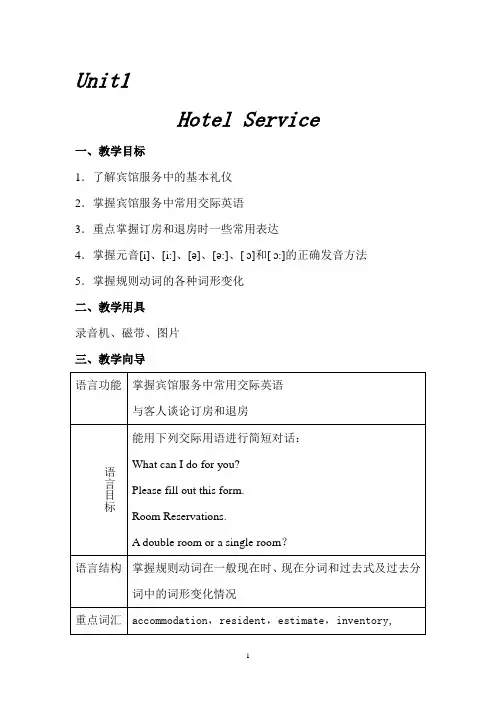
Unit1Hotel Service一、教学目标1.了解宾馆服务中的基本礼仪2.掌握宾馆服务中常用交际英语3.重点掌握订房和退房时一些常用表达4.掌握元音[i]、[i:]、[ə]、[ə:]、[ɔ]和[ɔ:]的正确发音方法5.掌握规则动词的各种词形变化二、教学用具录音机、磁带、图片三、教学向导Warm-up教学要求与建议1.提前布置学生预习单词并在课上指导学生根据图片牢记单词。
2.分组讨论宾馆服务中应该注意的一些问题。
3.安排学生两人一组,按课文对话进行练习。
练习答案1.Complete the dialogues.Your name, please;fill out;do you;Thank you Pronunciation Practice带领学生练习元音[i]、[i:]、[ə]、[ə:]、[ɔ]和[ɔ:]的正确发音,同时可以多举一些常见的带有这几个音的例子,进行比较。
Listening and Speaking一、教学重点1.掌握宾馆服务中常用交际英语。
2.注意听有关宾馆的名词术语。
二、教学建议角色扮演(ROLE PLAY)(1)明确口语活动的任务,要求学生仔细阅读对话。
必要时可做简单的对话示范。
(2)成对活动,轮流作Speaker A和Speaker B。
(3)教师巡视全班,聆听学生对话,并解答学生提出的问题。
(4)选出几个学生在班上表演。
(5)总结学生的表现,并及时纠正学生在对话过程中出现的错误。
三、练习参考答案A2、listen and fill in the blanks.traveling;access;offer;swimming;beachB2、Answer the questions.(1)Cancel a reservation.(2)There is no mention in the dialogue.(3)She will cancel the reservation for the customer.3、Complete the following sentences.(1)available(2)What time(3)tonight(4)will you(5)a double room4、略5、C B C B听力原文A2、listen and fill in the blanks.A hotel is a temporary home for people who are traveling. In a hotel the traveler can rest and has access to food and drink, either on the premises or nearby. The hotel may also offer facilities for recreation, such as a swimming pool, a golf course, or a beach.B3、Complete the following sentences.(1)The bathroom is available.(2) What time do I have to check out?(3) I'd like a room for tonight.(4) How many days will you stay?(5) I'd like to book a double room.5、Listen to the dialogue and answer the questions.R: Good morning, sir. What can I do for you?W: My name is White. I'm in Room 1008.I would like to know if it is possible to change my room. I'm not all happy with the one I've got. I couldn't even sleep last night. I was woken up several times by the noise the baggage elevator made. It was too much for me.R: Oh, dear. I'm so sorry to hear that, Mr White. I do apologize. Room 1008 is at the end of the corridor. It's possible that the noise is heard early in the morning when all is quiet.W: Anyhow, I'd like to change my room.R: Now let me see if I can find you a quiet room. Well, how about Room 1112? It's rather quiet. The room rate is the same as that of Room 1008. But it is one floor higher up. Do you mind moving one floor up, Mr White?W: No, not at all.R: Very good. Would you please sign in this room changing form? ... Here's the key to Room 1112. The bellman will help you with your baggage. Please return him the key to Room 1008. W: Thank you very much. I hope I'll have a sound sleep this evening.R: Be sure, Mr White. If there is anything more you need, please let us know.Language Bank带领学生练习记忆这些日常口语,也可布置学生自行学习,然后课后抽查。
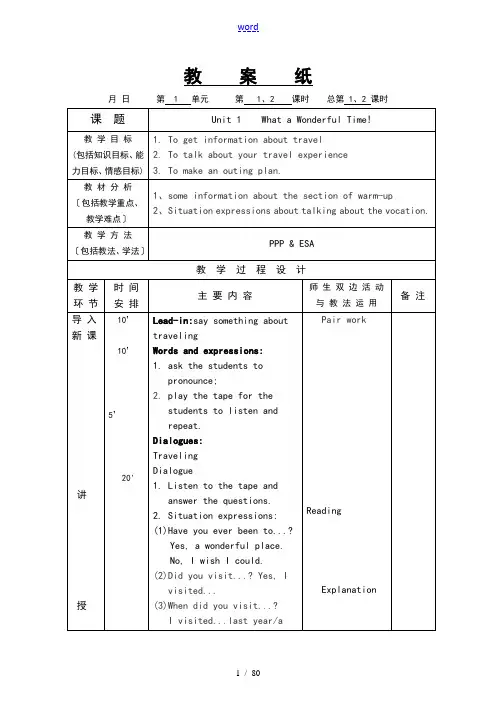
教案纸月日第 1 单元第 1、2 课时总第 1、2 课时〔教学环节一般包括复习旧课、导入新课、讲授新课、学生操作、教师点评、归纳总结、布置作业等〕教案纸月日第1单元第 3、4 课时总第3、4课时〔教学环节一般包括复习旧课、导入新课、讲授新课、学生操作、教师点评、归纳总结、布置作业等教案纸月日第1单元第 5、6 课时总第5、6课时〔教学环节一般包括复习旧课、导入新课、讲授新课、学生操作、教师点评、归纳总结、布置作业等〕教案纸月日第2 单元第 1、2 课时总第7、8课时〔教学环节一般包括复习旧课、导入新课、讲授新课、学生操作、教师点评、归纳总结、布置作业等〕教案纸月日第2 单元第 3、4 课时总第9、10课时〔教学环节一般包括复习旧课、导入新课、讲授新课、学生操作、教师点评、归纳总结、布置作业等教案纸月日第2单元第 5、6 课时总第11、12课时〔教学环节一般包括复习旧课、导入新课、讲授新课、学生操作、教师点评、归纳总结、布置作业等〕教案纸月日第3 单元第 1、2 课时总第13、14课时〔教学环节一般包括复习旧课、导入新课、讲授新课、学生操作、教师点评、归纳总结、布置作业等〕教案纸月日第3 单元第 3、4 课时总第15、16课时〔教学环节一般包括复习旧课、导入新课、讲授新课、学生操作、教师点评、归纳总结、布置作业等教案纸月日第3单元第 5、6 课时总第17、18课时〔教学环节一般包括复习旧课、导入新课、讲授新课、学生操作、教师点评、归纳总结、布置作业等〕教案纸月日第4单元第 1、2 课时总第19、20课时〔教学环节一般包括复习旧课、导入新课、讲授新课、学生操作、教师点评、归纳总结、布置作业等〕教案纸月日第4单元第 3、4 课时总第21、22课时〔教学环节一般包括复习旧课、导入新课、讲授新课、学生操作、教师点评、归纳总结、布置作业等教案纸月日第4单元第 5、6 课时总第23、24课时〔教学环节一般包括复习旧课、导入新课、讲授新课、学生操作、教师点评、归纳总结、布置作业等〕教案纸月日第5单元第 1、2 课时总第25、26课时〔教学环节一般包括复习旧课、导入新课、讲授新课、学生操作、教师点评、归纳总结、布置作业等〕教案纸月日第5单元第 3、4 课时总第27、28课时〔教学环节一般包括复习旧课、导入新课、讲授新课、学生操作、教师点评、归纳总结、布置作业等教案纸月日第5单元第 5、6 课时总第29、30课时〔教学环节一般包括复习旧课、导入新课、讲授新课、学生操作、教师点评、归纳总结、布置作业等〕教案纸月日第6单元第 1、2 课时总第31、32课时〔教学环节一般包括复习旧课、导入新课、讲授新课、学生操作、教师点评、归纳总结、布置作业等〕教案纸月日第6单元第 3、4 课时总第33、34课时〔教学环节一般包括复习旧课、导入新课、讲授新课、学生操作、教师点评、归纳总结、布置作业等教案纸月日第6单元第 5、6 课时总第35、36课时〔教学环节一般包括复习旧课、导入新课、讲授新课、学生操作、教师点评、归纳总结、布置作业等〕教案纸月日第7单元第 1、2 课时总第37、38课时〔教学环节一般包括复习旧课、导入新课、讲授新课、学生操作、教师点评、归纳总结、布置作业等〕教案纸月日第7单元第 3、4 课时总第39、40课时。
中职英语第二册u n i t1(总12页)--本页仅作为文档封面,使用时请直接删除即可----内页可以根据需求调整合适字体及大小--江苏省中等专业学校集体备课电子教案江苏省中等专业学校集体备课电子教案江苏省中等专业学校集体备课电子教案江苏省中等专业学校集体备课电子教案江苏省中等专业学校集体备课电子教案Ask students to read the four vowels and words, make sure they know them and can read them correctStep one: phonetics study1. Ask students to try to read the words and phonetics by themselves,they may read them carefully with referring to the phonetic symbols.Ask the students to read them after the teacher/tape, they should pay attention to the pronunciation. And then ask them to read thewords and phonetics altogether. Correct their mistakes if they haveafter reading the words and phonetics.Ask individuals to read the words and vowels, they should read them correctly. Give them some help if they have while reading thewords.加ed 以后的发音有如下三种:1)ed 在清辅音[p][t][k][f][s][h]等后读[ t ], 如:helped, washed, watched, marked, finished, stopped, skipped, cooked, worked2)ed 在浊辅音[d][g][v][z][r][m][n]等后及元音后读[d], 如:cleaned, played, prepared3)ed在[t][d]后读[id], 如:painted, started, visited2. ask the students to read the sentences, and they should knowhow many times they hear the given vowel in each sentence below,write the number in the bracketsCheck up the answersKey: ①listened answered planned prepared②regarded repeated surrounded ③talked looked helpedStep two: grammar (exclamations感叹句 )。
月日第 1 单元第1、2 课时总第1、2 课时(教学环节一般包括复习旧课、导入新课、讲授新课、学生操作、教师点评、归纳总结、布置作业等)月日第 1 单元第3、4 课时总第3、4 课时(教学环节一般包括复习旧课、导入新课、讲授新课、学生操作、教师点评、归纳总结、布置作业等月日第 1 单元第5、6 课时总第5、6 课时(教学环节一般包括复习旧课、导入新课、讲授新课、学生操作、教师点评、归纳总结、布置作业等)月日第 2 单元第1、2 课时总第7、8 课时(教学环节一般包括复习旧课、导入新课、讲授新课、学生操作、教师点评、归纳总结、布置作业等)月日第 2 单元第3、4 课时总第9、10 课时(教学环节一般包括复习旧课、导入新课、讲授新课、学生操作、教师点评、归纳总结、布置作业等月日第 2 单元第5、6 课时总第11、12 课时(教学环节一般包括复习旧课、导入新课、讲授新课、学生操作、教师点评、归纳总结、布置作业等)月日第 3 单元第1、2 课时总第13、14 课时(教学环节一般包括复习旧课、导入新课、讲授新课、学生操作、教师点评、归纳总结、布置作业等)月日第 3 单元第3、4 课时总第15、16 课时(教学环节一般包括复习旧课、导入新课、讲授新课、学生操作、教师点评、归纳总结、布置作业等月日第 3 单元第5、6 课时总第17、18 课时(教学环节一般包括复习旧课、导入新课、讲授新课、学生操作、教师点评、归纳总结、布置作业等)月日第 4 单元第1、2 课时总第19、20 课时(教学环节一般包括复习旧课、导入新课、讲授新课、学生操作、教师点评、归纳总结、布置作业等)教案纸月日第 4 单元第3、4 课时总第21、22 课时(教学环节一般包括复习旧课、导入新课、讲授新课、学生操作、教师点评、归纳总结、布置作业等教案纸月日第 4 单元第5、6 课时总第23、24 课时(教学环节一般包括复习旧课、导入新课、讲授新课、学生操作、教师点评、归纳总结、布置作业等)教案纸月日第 5 单元第1、2 课时总第25、26 课时(教学环节一般包括复习旧课、导入新课、讲授新课、学生操作、教师点评、归纳总结、布置作业等)教案纸月日第 5 单元第3、4 课时总第27、28 课时(教学环节一般包括复习旧课、导入新课、讲授新课、学生操作、教师点评、归纳总结、布置作业等教案纸月日第 5 单元第5、6 课时总第29、30 课时(教学环节一般包括复习旧课、导入新课、讲授新课、学生操作、教师点评、归纳总结、布置作业等)月日第 6 单元第1、2 课时总第31、32 课时(教学环节一般包括复习旧课、导入新课、讲授新课、学生操作、教师点评、归纳总结、布置作业等)月日第 6 单元第3、4 课时总第33、34 课时(教学环节一般包括复习旧课、导入新课、讲授新课、学生操作、教师点评、归纳总结、布置作业等月日第 6 单元第5、6 课时总第35、36 课时(教学环节一般包括复习旧课、导入新课、讲授新课、学生操作、教师点评、归纳总结、布置作业等)月日第7 单元第1、2 课时总第37、38 课时(教学环节一般包括复习旧课、导入新课、讲授新课、学生操作、教师点评、归纳总结、布置作业等)月日第7 单元第3、4 课时总第39、40 课时(教学环节一般包括复习旧课、导入新课、讲授新课、学生操作、教师点评、归纳总结、布置作业等月日第7 单元第5、6 课时总第41、42 课时(教学环节一般包括复习旧课、导入新课、讲授新课、学生操作、教师点评、归纳总结、布置作业等)月日第8 单元第1、2 课时总第43、44 课时(教学环节一般包括复习旧课、导入新课、讲授新课、学生操作、教师点评、归纳总结、布置作业等)月日第8 单元第3、4 课时总第45、46 课时(教学环节一般包括复习旧课、导入新课、讲授新课、学生操作、教师点评、归纳总结、布置作业等月日第8 单元第5、6 课时总第47、48 课时(教学环节一般包括复习旧课、导入新课、讲授新课、学生操作、教师点评、归纳总结、布置作业等)月日第9 单元第1、2 课时总第49、50 课时(教学环节一般包括复习旧课、导入新课、讲授新课、学生操作、教师点评、归纳总结、布置作业等)。
中职英语语文版(2023)基础模块2 Unit 1 The Spring Festival Listening and Reading 教学设计(表格式)Unit 1 The Spring FestivalTeaching plan---listening and reading课程Unit 1 The Spring Festival 建议学时About 4教学目标1. Teachers help and train students to be able to narrate activities during the Spring Festival in English, and enable students to exchange some customs and experiences during the Spring Festival; 2. Guide students to deepen their love for traditional Chinese culture by understanding the story of "Nian"; 3. Assist students in mastering and understanding the basic structure of simple sentences; 4. Provide students with the opportunity to practice in a group of two and explore learning in a group of many, establish an independent learning environment, and cultivate students' good habits of Cooperative learning and inquiry learning.教学重点重点词汇和短语dumpling, lantern, couplets, firework, celebrate, relatives, tradition, encourage, Gala; temple fair, lantern show, lucky money, lunar month, take part in, look forward to, be prepared for, encourage sb. to do sth., make one’s decision, learn from重点句型How was your Spring Festival What did you do (during the Spring Festival) They encouraged me to... It was interesting and wonderful.重点语法 1. Sentence components 2. The Five Basic Structures of Simple Sentences教法与学法 1. Group Cooperative learning method 2. Task based teaching method 3. Competitive Incentive Learning Method 4. Autonomous learning method教学手段PPT、Mp3教学内容教学设计活动1 1. Teachers can first inspire students to try reading out the given questions and six verb phrases: visit relatives or friends, hang up red lands, put up couplets, have a get to another, make Chinese dumplings, get lucky money. 2. When students have difficulties or obstacles in pronunciation, teachers should provide timely help and support, such as distinguishing syllables or pointing out the same sound, such as hang and lanterns. In order to deepen students' understanding of phrases, teachers can release pictures on the presentation (PPT) and quickly point to a certain picture. Please ask all students who can speak to stand up and say it together, and see which group stands up and reads more. 3. After the students have basically mastered the pronunciation, the teacher asks them to work in pairs to conduct a question and answeractivity, requiring them to answer the questions in complete sentences.4.Finally, a simple sentence pattern can be used to answer the question:I got lucky money from During the answer process, as it involves events that occurred during the previous Spring Festival, students are reminded to pay attention to the use of the past tense of verbs.活动2 1.Before students start practicing in pairs, the teacher leads them to read the questions several times and then asks in a probing tone: Do you understand this sentence Who can tell us When asked: Where did you celebrate the last Spring Festival Teachers can choose Interrogative to inspire students: In Beijing or Shanghai At your home or in your grandparents' home When teachers explain why we should keep the tradition of celebrating the Spring Festival, they should provide some phrases or sentences to help students understand the problem and expand their knowledge, such as: because farmers need a good rest, drive away the dangerous animals or bad people, good wish for the coming new year, starting of the spring, and so on. 2.Is the Spring Festival holiday one of your favorite holidays You can also review some other festivals, such as May Day, the Dragon boat Festival, the Mid-autumn Day, National Day, and even Children's Day. 3. The second question is that the teacher can have each student ask three different classmates the same question. 4. Third question, the teacher provides phrases and sentences to help students organize a few sentencestogether, forming a small paragraph, and allowing students to proficiently read it out. 5. The teacher organizes all students to practice Q&A in pairs, and conducts inspections, supervision, and guidance. The third question can also stimulate students' thinking and write some good ideas and ideas on the blackboard.Part I Listening 1.Before playing the listening audio, first have the students look at the pictures and ask: Do you know "Guonian" What do you do during the Spring Festival When does it start and end Wait for a question. Students may only be able to answer some of the questions, and teachers should remind students to listen carefully, be patient, and pay attention to capturing the details in the questions. At the same time, provide several key phrases: get togethers, relationships, Lunar month, the Lantern Festival. 2. Play the listening materials and complete the exercise. 3. Play the listening again and check and correct the answers. 4. The teacher asked the students to check the answers and read out the complete five practice sentences.Part II Reading At the beginning of the reading activity, it is necessary for the teacher to lead the students to read the text aloud 2-3 times. Teachers can provide several discourse related questions for students to ask and answer each other in order to achieve comprehension. You can also give some time for students to work together and ask each other key or difficult questions in the text. The analysis of key and difficultpoints provided to teachers in the teaching reference can be selectively explained to students. Finally, the teacher proposes several key phrases or sentence patterns that students need to master based on their learning of the discourse.Part III Speaking 1. The teacher leads the students to read down the relevant phrases in the conversation first: Envelope sb. to do sth., be prepared for, Make one's decision, learn from 2. The teacher asks questions and asks students to put the learned phrases into sentences based on the conversation content, in order to achieve the purpose of using the learned content. For example: What did you do in the Spring Festival - I learned to cook dinner What did your parents tell you during the holiday - They encouraged me to work hard 3. The teacher leads the students to repeatedly read the dialogue several times, and then has the entire class work in pairs to role-play. 4. The teacher lists the questions and students choose the correct answers based on the questions.Culture Corner The Origin of Spring FestivalSelf-check After completing the content of this unit, students will conduct a self check against the language knowledge such as vocabulary and phrases in the unit to assess their mastery. Based on the test results, identify the shortcomings and learn to summarize, self-evaluate, and reflect after class. During this process, teachers can reread the listed testvocabulary and provide necessary guidance based on the actual situation, guiding students to cultivate good learning habits, and promoting the continuous improvement of students' language learning and autonomous learning abilities.。
Unit 1We laughed into tears!Part1: 教材分析(Analysis of the teaching material)本课时系教材《英语 2 》(基础模块高教版)第一单元的第一部分,学生听一段关于和家人度假描述的对话。
训练学生在一定的语境下用合适的方式和语句组织关于描述假期活动的对话。
Part2: 教学目标(Teaching aims)Ss can understand expression of vacation description and make a dialogue discussing vacationLead-inAsk the students where did they go and what they did in the summer vacation and winter vacation. (Group discussion and then answer my questions)Step1:Lead students read the phrases and ask Ss to tick the activities they had taken part in.then check the answer.Step2:Teacher show the pictures for the Ss , explain the requests and then play the radio for theSs. Next, teacher asks some students to answer these questions.Listening & SpeakingPart1: 教材分析(Analysis of the teaching material)本课时系教材《英语 2 》(基础模块高教版)第一单元的听力及口语第一部分,学生听一段关于 Cindy 和家人度假描述的对话。